#retj redesign 2024
Explore tagged Tumblr posts
Text

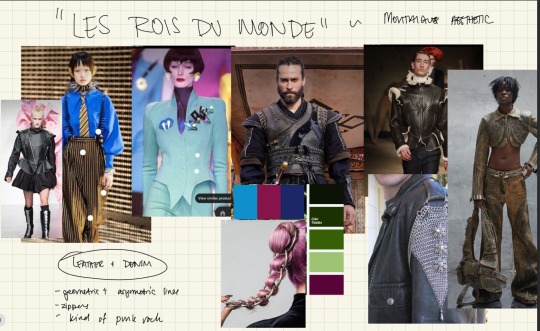
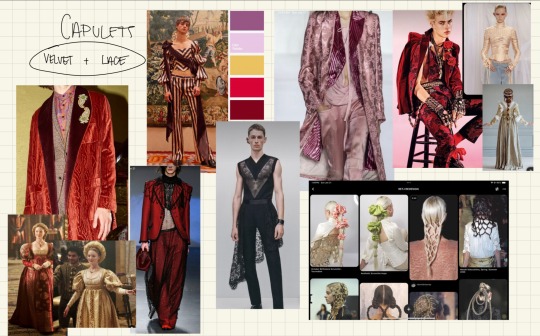

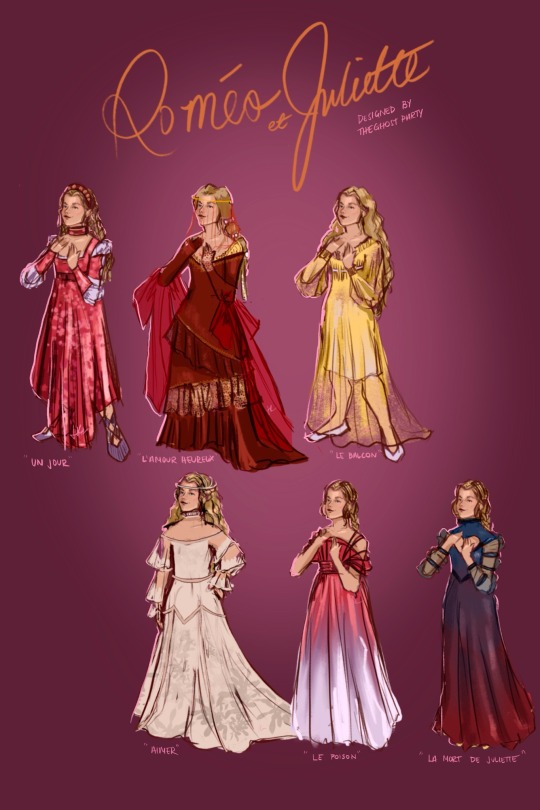
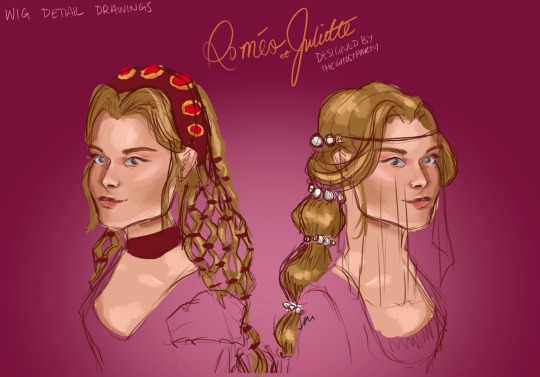
Roméo et Juliette: de la Haine à l'Amour - Redesign - 2024
To understand my completely unnecessary desire to redesign a musical that is over twenty years old, you have to understand that Romeo et Juliette is my Roman Empire. Long explanation under the break.
I wanted this design to be an homage in the silliest way possible.
I really leant into the sensibilities of original costume designer Dominique Borg, who used contemporary colour and technique and applied it to historical (or pseudo-historical) silhouettes.
Broadly, I wanted the Montagues to feel English in their shapes--Elizabethan doublets, high necklines, and ruffs, in homage to Shakespeare and the source text. They're all leather, denim, silver hardware--a little bit punk with status.
The Capulets would be deeply Italian Renaissance in their silhouettes, in reference to the setting of the play. They're all velvets, lace, chiffon, satins, and gold hardware--giving them an airiness of the Mediterranean while still allowing some drape here and there.
I wanted each family to have a slightly more broad palette than most versions afford them--which is why the Montagues have a smattering of green and magenta while the Capulets play with some soft yellows and lavenders.
The ball scene is largely Arthurian in inspiration--just because I took the idea of "what would the 1500s consider vintage and costume-y in the same way we think of the Victorian era" and ran away with it. There's also some silly Y2K nonsense because I rewatched the "On dit dans la rue" music video and thought "What if the Capulets threw this big Arthurian affair with full elegance and the Montagues cobbled together some gay club outfits circa 1998 fits out of a suit of armour."
FINALLY, I wanted Roméo and Juliette to take on elements of each other's family's style and colours for the end of the play--because to be loved is to be changed.
So here is a breakdown of my choices for each of the looks.
Un Jour: Here we see Roméo in his base look. It's a two-tone patent leather double with multiple zipper details. The peplum is criss-crossed zippers. The wings over the shoulder seams are edged with zipper teeth. The ruff detail at the neckline is also edged with zipper teeth. He has along zipper across the front of his boot like he's trying to be the next Sailor Moon. I don't know y'all. I went a little feral with trying to figure out all the places I could put zippers in.
Juliette is the most juvenile looking in Un Jour. I imagine that in this scene, she's being dressed by her family instead of her own volition.
She's in an asymmetrical, empire-waisted gown that is likely a brocaded or printed silk. Her chemise is a sheer lavender georgette or chiffon that peaks through the lacing at the shoulders and along the upper arms. She has a velvet choker and velvet belt and a heavily stoned velvet headband. Her hairstyling (it would have to be a wig, it would be NUTS to not make this a wig) is an homage to the open-weave Juliet caps that were similar to nets worn in the period on hair. Italy was, fun fact, one of the few countries where women didn't cover their hair during the renaissance.
L'amour heureux: As I explained above, Roméo's outfit is so silly. The wrap around glasses. The one arm of armour. The sheer, stoned period shirt. The gold brocade on the trousers. The pearl earring. The many, unnecessary belts. Bless this mess. It's also a cheeky little nod to Baz Lurhmann's Romeo + Juliet.
Juliette is, ostensibly, cosplaying as Guinevere or Lady Macbeth or Ophelia or any number of Middle Ages women. The ball is the Capulet's opportunity to really sell their daughter as marriage material so I wanted the look to feel bridal, hence the veil. I wanted to give reference to exaggerated surcote sleeves without actually doing them, hence the sleeve-into-glove and bow detailing with trails down to the floor. There is also a hint of yellow chemise underneath, which is actually just her Le balcon look underdressed for ease of the quick change (yes, I did think about this.) The dress is velvet with one panel of lace in-set into the underskirt. The bows are satin-face organza.
Le balcon: Romeo would change into his base again (during Le Poète). Juliette is in a simple yet totally impractical sheer chemise + slip combo. I wanted this soft yellow for this sequence because I always think about the lines "O she doth teach the torches to burn bright!" and "But soft! What light through yonder window breaks?/It is the east and Juliet is the sun" when it comes to describing her. The chemise would likely be a chiffon, while the slip would be silk.
Aimer: I say this with my whole chest--I hate how they changed the palette for Aimer in the 2010 production. I want my lovers soft and angelic and matching in this moment of union. Here we see a bit more of Romeo's lace shirt--his sleeves are laced like Juliette's in the first look. His doublet, trouser, boot combo are off-white leather in homage to the original production. Juliette's dress has a similar train length to her ball look (again, bridal) and we see the neckline creep up into a ruff (Elizabethan, rather than Italian). Lots of sheer net and lace with cream bridal satin as a skirt. Tiered sleeves. A little circlet on her head.
Le poison: Honestly? Just wanted her to have another outfit change before her death dress as a transitional choice. There's so much more of the purple in this look because it's going to take us into the blue elements of the final dress.
La mort de Roméo/Juliette: Again. To be loved is to be changed. Juliette has a dropped waistline, a high neckline and ruff, and a heart shaped cut-out detail (see: boob window). She's straight up in blue, and all the sweet and soft pinks of her youth are gone. Romeo has lost his high neckline, ruff, wins, and peplum in favour of a shorter Italian silhouette. He's asymmetrical (a call-back to Juliette's asymmetry) and all the edging detail is done in red. Mantua as a setting is patchworked, torn, and dirty, so I imagine the doublet is pieced together from scraps of jersey (so it's drippy and sad and hangs off him in a lovely manner).
#romeo et juliette#damien sargue#cecilia cara#joyce draws#retj redesign 2024#retj#this is the most unhinged thing I have ever dreamed up#anyways more to come soon#will probably do mercutio and the prince and benvolio and tybalt together as one post#did little 14 year old joyce think this is what she would STILL be talking about? nO#also if you've ever wondered what my costume design process looks like it's this
55 notes
·
View notes
Text
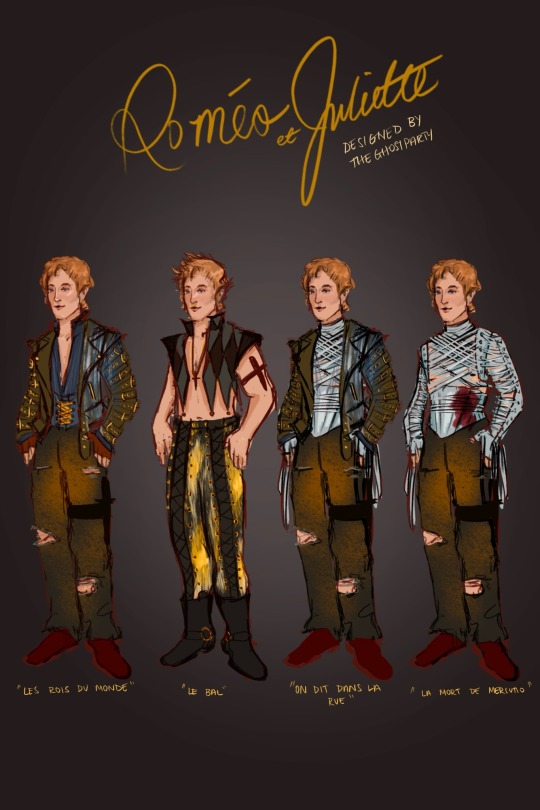
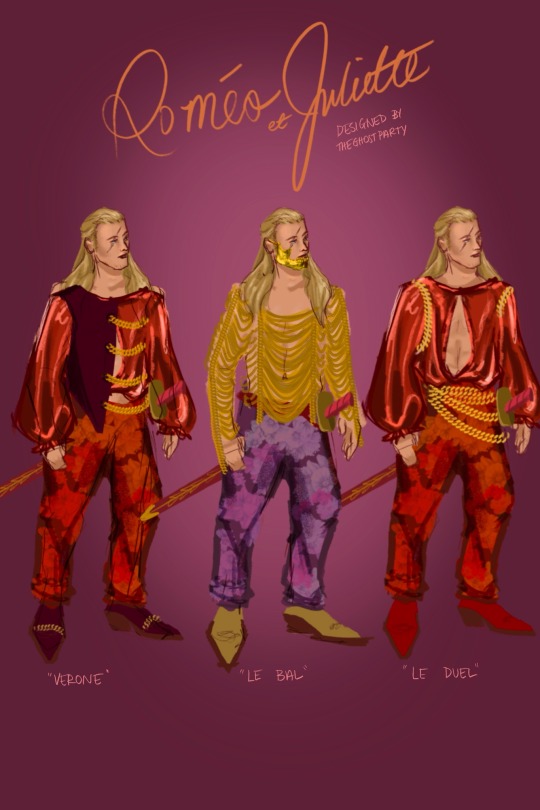
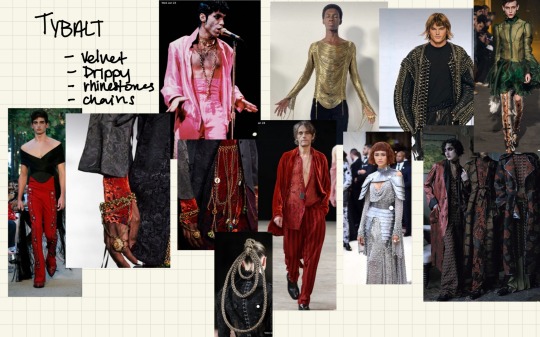
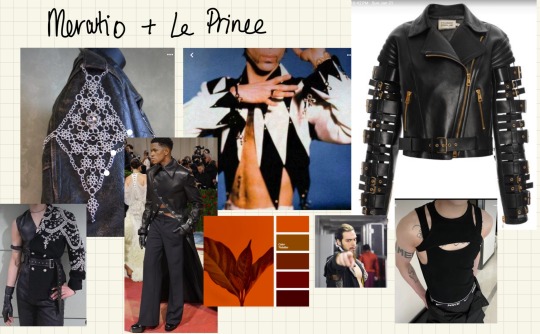
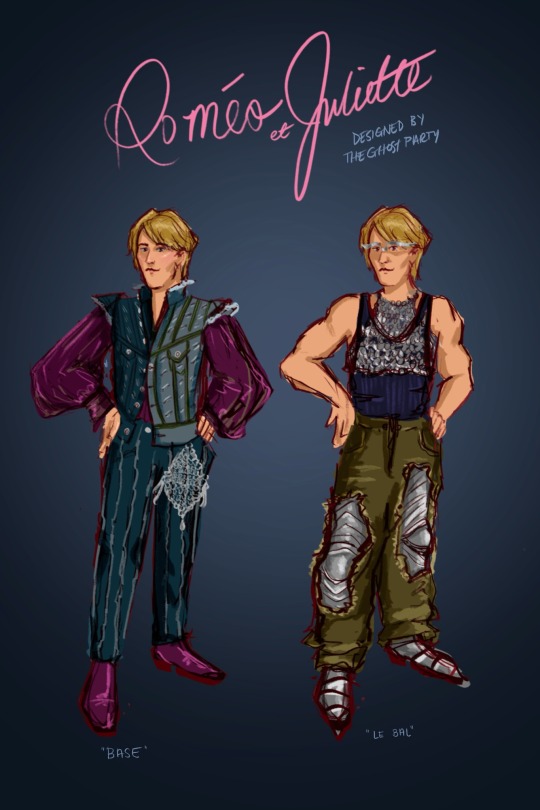
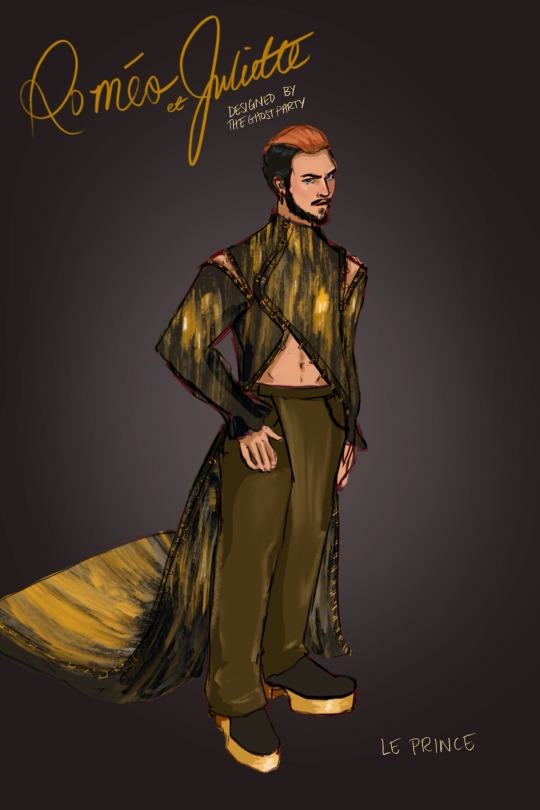
Roméo et Juliette: de la Haine à l'Amour - Redesign - 2024
If you missed part one with Roméo and Juliette, click here. Once again, long design explanation.
When designing Mercutio specifically, I turned very explicitly inwards in my belief that Mercutio is not a Montague and should not be tied to the Montagues solely. Furthermore, Mercutio has FAMILY--he's the Prince's cousin and if we want to get really semantic about it, he also has a brother, Valentine.
All this being said, in designing Mercutio, I needed to tie him to Le Prince (Escalus) and I did that mostly in dictating that these are the characters who are allowed to wear black, mostly black leather. It's a distinction that goes mostly unnoticed until its pointed out, but no other designs incorporate deep black tones. There's also this strong, olive green tone that borrows from the Montague palette and gold hardware that borrows from the Capulet palette. The Prince's family gets to straddle the line between both worlds.
I thought very texturally for the Montagues and Capulets, so in trying to give the Prince's family something distinct, I landed on this brushstroke texture to give all the leather and denim pieces a custom feeling.
In his Les Rois du Monde look (his base look--I imagine this explicitly directorial choice to have him and the Prince enter together at the top of Vérone and have Mercutio break away to join the Montagues), there is hints of this painterly texture in blue as opposed to the gold of the Prince. I wanted to feel like every alignment Mercutio has with the Montague family is an active choice on his part. I imagine him painted those swaths of blue himself. His trousers are a bleached faded, torn denim.
We see the true royal gold in Le Bal, like, I think it's just funny to think Mercutio already owned these trousers and said "Fuck it" and wore them to dress up in. His look is explicitly jester themed. It's a little bit "Earring Magic Ken Doll" coded, which delights me to no end.
This is also a good place to point out how fixated I became on closure methods in garments. In Roméo's initial design, there is a strong focus on zippers, Le Prince's jacket is held together with gold hook and eye tape at all the seams, and with Mercutio it's all about lacing.
Part of this is in reference to the explicitly gendered ideas around corsetry and playing with that in tandem with Mercutio's generally accepted queer readings. It's also an interesting metaphor to think about being bound--by duty, by honour, by friendship, by tradition--something that Mercutio is so explicitly caught in between in the Montague-Capulet feud.
His final look during Le Duel, is a take on a Jean Paul Gautier design, and is the most partisan look for Mercutio. Doffing his jacket exposes this soft satin and coutil corset top in the faintest hint of blue. A soft underbelly of allegiance that would take to stage blood SO well (and would make who ever was dressing and laundering this show absolutely hate me as a designer, but I digress).
I also think it makes him a nice mirror to Tybalt, who's overarching design element is gold chains.
Tybalt's design is wholly referential to Mark Seibert's Tybalt. Is it because I can never get that little gold and red cropped jacket out of my brain? Perhaps. But I also like to think that design for Tybalt acts as a reflection of Mercutio. The inherent softness assigned to the Capulet family's design (silks, velvets, chiffons) plays really nicely with how much machismo is implied in Tybalt's characterization.
During Vérone, we see him in a half doublet, likely of a low-pile velvet, a satin faced silk period shirt open in an absolutely impractical way, and a floral print denim trouser. I also gave him a little cuban-heeled boot. For fashion.
Tybalt is a good place to also point out that weapons are very intentionally placed in and out of scenes. Mercutio always has a dagger. Roméo leaves his behind during Aimer. Benvolio does not carry one. Tybalt has an ornately sheathed sword. There is this undercurrent of violence for these characters that is dressed up and dressed down, but persists.
In Le Bal, I really leant into the idea of chainmail for this character, in keeping with the concept of chivalry and Arthurian influences. There's a little bit of royal purple thrown in there for good measure as well as a jaw-bone mask that, at best, is foreshadowing and, at its shallowest, looks cool as hell.
During Le Duel, I wanted to strip our fighters down to exposed skin. A lot of this is to do with one of my favourite versions of this scene, Zeffirelli's 1968 Romeo and Juliet. What I love about the sequence is how it devolves from nobel duel to outright brawl--from a distance to something very close and personal. It's the type of step by step tension-building that I really enjoy: where there are moments (when they're just shouting words back at forth, when they're drawing their weapons, when Mercutio would doff his jacket, when Tybalt doffs his doublet) when the fight could have de-escalated. When they could have walked away. But of course, it's not the play if they do.
I just imagine seeing Mark Seibert and Bereczki Zoltán fight would be fun, ultimately.
And now onto Benvolio. I fixated on paring down his looks, and quite frankly, if it weren't for how much I enjoy his little twink clubbing outfit, I would have probably only given him one costume. My justification for this is that Benvolio gets to live. Ostensibly, he has a lifetime past this play of changing to do. I feel very strongly about the idea of Benvolio as a narrator, Benvolio as a passive presence that is forced to become active. He's not certain in the same way that Roméo and Mercutio are about love and hate. He literally spends a whole song stagnating and waffling on how the hell he's going to tell his cousin that his wife is dead. He runs around following their impulses, patching over their problems. I have a lot of feelings about Benvolio as a character.
He's really the softest of the Montague characters in textures: his doublet is torn and slashed denim, his shirt is some sort of billowy linen blend. He has a little bit of metal flair in the form of this thigh adornment, but really he's quite simple--and my comparison to Roméo and Mercutio, he's quite warm. That hint of magenta on Roméo is a full on feature on Benvolio.
I accept any and all slander about my choices for his Le bal look, but by god do I think it's silly and it brings me joy. Suit of armour under ripped green denim, a little navy ribbed singlet with a silver chainmail crop top over it? Lensless silver glasses frames? It makes no real sense, but I stand by my "We're sneaking into the Capulet's ball tonight with very short notice, here's what we can cobble together" reasoning.
#romeo et juliette#romeo es julia#romeo und julia#romeo e giulietta#bereczki zoltan#mark seibert#cyril niccolai#leonardo di minno#retj#resj#joyce draws#retj redesign 2024#boy oh boy I hope cyril niccolai who literally follows me never sees this post#tw: blood#I wish I could tell my younger self that watched this musical that I did in fact grow up to be a professional designer and this is my job
28 notes
·
View notes
Note
if youre not already, would you ever consider designing valentine in the style of retj? id love to see that, as a character concept hes like super interesting to me
I have and I will!
I'm actually a little bit obsessed with the prominence of some of the unnamed/tertiary characters in the original production.
Like, La Muette should be a staple of every show just for accessibility, who is that red haired dancer who tells Tybalt off and says Juliette will never love him, who is that blonde dancer who Benvolio nearly kisses before he throws her on the ground in Vérone? Where is/where WOULD Rosaline be in all of this? Le poète is an OBVIOUS William Shakespeare stand-in and yet all other productions (except Les Enfants de Vérone?) basically axe him. And of course, Valentine.
And I think I'm going to illustrate these characters as a representation of the larger ensemble.
4 notes
·
View notes
Text
I'm about to drop Roméo and Juliette's redesign and I accidentally wrote an essay explaining all my design choices OOPS
4 notes
·
View notes